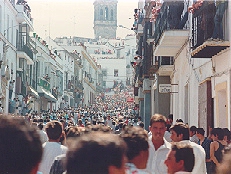|
|
|
Arcos de la Frontera
Arcos has been inhabited since prehistoric times. Legend has it that one of Noah's sons founded Arcos. It was more probable that it was the Iberians. After the Iberians, the Romans named it Arcobriga. Arcos is an archetypal white town with a labyrinthine old quarter winding up to a ruined castle. At the top of the cliff is the Plaza de Espana from which the rich fertile Guadalete river valley can be seen. This is a magnificent view of surrounding farmland and the embalse (reservoir). Also at the pinnacle are the Parador (Spain's government owned hotels) and the Iglesia (church) de Santa Maria de la Asuncion. This church is built in late Gothic-Mudejar (hybrid Christian-Islamic style of architecture) style and is noted for the intricate wood carving of the choir stalls.
This is La Iglesia de Santa Maria de la Asuncion. That is the church of Saint Mary of the Ascension. The last pic is a close-up of some of the gargoyles. We got to tour the inside of the church, and you can see those pics below.
The church faces a courtyard, and these photos were taken in that courtyard. Opposite the church is an overlook.
Here we are at the overlook.
From the overlook, it is a straight drop down. The first two pics are from the camera over the side and pointing down. The other pics show the great scenery.
This is the church of San Pedro, or Saint Peter. It is built at the edge of the gorge.
These are various shots from around the town.

Arcos is also a local town where they run a bull. Around Easter in Pomplona about 30 bulls are released in the streets to mark the start of bull fighting season. In small local towns like Arcos, one or two bulls run through the streets. The first year we were here Dawn and I got to see this. This is quite a popular event, as you can see in the pic.
Here are the pictures from inside the church of Santa Maria. The architecture was impressive, and the woodcraft of the alter pieces were a sight to see. The last pic is of a pipe organ carved from wood. We were not allowed to use a flash inside the church so the pics in here were blurry.
Back to the pics